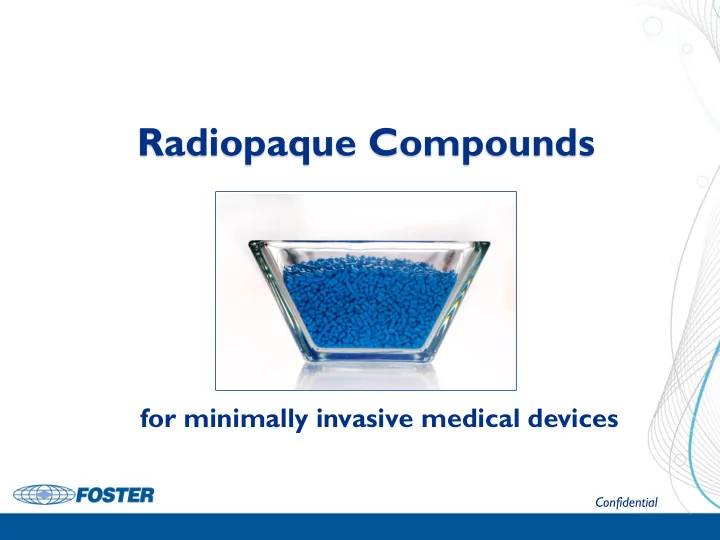

Radiopaque Compounds for minimally invasive medical devices Confidential
Purpose of Radiopaque Compounds Polymers: inherently transparent to x-ray Radiopaque fillers: visible under x-ray Radiopaque compounds: visible under x-ray imaging or fluoroscopy Surgeon can follow device through body Confidential
Applications PTCA Catheters Central Venous Catheters Foley Catheters Naso Gastric Feeding Tubes Pacemaker Lead Placement Neurovascular Catheters Diagnostic Cardiovascular Catheters Confidential
Polymers used for Devices Confidential
Common Radiopaque Fillers Barium sulfate Bismuth subcarbonate Bismuth trioxide Bismuth oxychloride Tungsten Confidential
Selecting Radiopaque Fillers Base resin Tubing wall thickness Surface smoothness needed Color Physical properties needed in end device Where device will be used in the body Sterilization technique Economics Confidential
Barium Sulfate (BaSO 4 ) First widely used in medical formulations Relatively inexpensive white powder Very process stable Must be pre-dried Loadings of 40-60% depending on polymer Require high loading for equivalent radiopacity White: easy to color but poor tinting strength Confidential
Barium Sulfate Typical Loading Levels Polyketone Fluorinated Ethylene… Polyurethane, Aliphatic Polyurethane, Aromatic Polyamide 11 Polyamide 12 Polyether Block Amide Polyvinyl Chloride Polypropylene Polyethylene 0% 10% 20% 30% 40% 50% 60% 70% Confidential
Bismuth Subcarbonate (Bi 2 O 2 CO 3 ) White: strong pigment & difficult to color match Loadings of 30-50% by weight possible Unstable at temperatures above 400 o F (yellows) Not compatible with some TPU’s Confidential
Bismuth Subcarbonate Typical Loading Levels Polyketone NOT RECOMMENDED Fluorinated Ethylene… NOT RECOMMENDED Polyurethane, Aliphatic NOT RECOMMENDED Polyurethane, Aromatic Polyamide 11 Polyamide 12 Polyether Block Amide Polyvinyl Chloride Polypropylene Polyethylene 0% 10% 20% 30% 40% 50% 60% Confidential
Bismuth Trioxide (Bi 2 O 3 ) Yellow color Turns brown at high processing temperature Can be loaded up to 60% by weight Can get gritty surfaces Compatible with most resins Confidential
Bismuth Trioxide Typical Loading Levels Polyketone Fluorinated Ethylene… Polyurethane, Aliphatic Polyurethane, Aromatic Polyamide 11 Polyamide 12 Polyether Block Amide NOT RECOMMENDED Polyvinyl Chloride Polypropylene Polyethylene 0% 10% 20% 30% 40% 50% 60% Confidential
Bismuth Oxychloride (BiOCI) White color More temperature stable than bismuth subcarbonate Compatible with a wide range of resins “Platelet - like” particles provide smooth shiny surface Susceptible to UV degradation (requires UV stabilizer) Difficult to color (can produce a “pearlescent” finish) Confidential
Bismuth Oxychloride Typical Loading Levels NOT RECOMMENDED Polyketone NOT RECOMMENDED Fluorinated Ethylene… NOT RECOMMENDED Polyurethane, Aliphatic NOT RECOMMENDED Polyurethane, Aromatic Polyamide 11 Polyamide 12 Polyether Block Amide Polyvinyl Chloride Polypropylene Polyethylene 0% 10% 20% 30% 40% 50% 60% Confidential
Tungsten (W) Very heavy, dark metal powder (hard to color) Compatible with virtually any resin Loading up to 90% by weight possible Can show matte finish in high loadings Very abrasive (high wear to process equipment) Filler of choice in very thin walled devices Oxidation in the presence of oxygen and heat Highly flammable (pay particular attention to drying techniques) Confidential
Tungsten Typical Loading Levels Polyketone NOT RECOMMENDED NOT RECOMMENDED Fluorinated Ethylene… Polyurethane, Aliphatic Polyurethane, Aromatic Polyamide 11 Polyamide 12 Polyether Block Amide Polyvinyl Chloride NOT RECOMMENDED Polypropylene Polyethylene 0% 10% 20% 30% 40% 50% 60% 70% 80% 90% Confidential
Confidential
Radiopaque Filler Summary Confidential
Recommend
More recommend